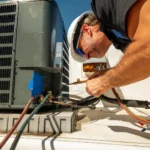

What does the future look like for your electrical contracting business? For many contractors in your field, electrification and the vast opportunities it creates have become a priority.
The demand for electrification is exploding. Businesses and public organizations are replacing systems that rely on fossil fuels with electrical solutions. Electrification is a way for large buildings to manage costs while achieving pollution reduction and sustainability goals, but there is a need for qualified partners to achieve these benefits.
The market for commercial building electrification is growing quickly, and pivoting to electrification is a sound strategy for success.
Making commercial electrification the primary focus of your business can represent a significant change in your operation, especially if you have a background as a residential contractor. However, there are several arguments in favor of choosing this path.
You should know that the global commercial EV market is growing at a compound annual growth rate of 23.8%, creating a need for a commercial charging infrastructure. Experts also expect building electrification to become the norm by 2030 as more organizations work toward near-zero emission buildings.
Let’s take a closer look at the benefits of centering your value proposition around commercial facility electrification. Here are some ways that you can come out on top:
Incentives at the federal, state, and local levels are making the electrification of buildings more appealing than ever. Owners (and even tenants, in some cases) can save on commercial building electrification thanks to the 179D tax credit, also known as the Commercial Buildings Energy-Efficiency Tax Deduction.
This tax break is part of the $500 billion invested in pollution reduction and clean tech from the federal government. Besides benefiting from tax breaks and other incentives, businesses have a strong rationale to invest in retrofitting and electrification projects as more consumers and investors choose companies with strong ESG programs.
EV adoption is a major factor driving the modernization of the electrical infrastructure. Thanks to the NEVI program, states have access to a combined $7.5 billion in funding to develop alternative fuel corridors along highways and make EV charging accessible in rural areas.
There are additional efforts at the state and municipal levels to develop a strong EV charging infrastructure, especially in the eight states that plan to gradually phase out new ICE vehicle sales. Plus, a growing number of businesses offer private charging as a perk to employees and patrons.
Commercial facility electrification opportunities include installing Level 2 and DC Fast chargers. There will be plenty of jobs that require work on the existing electrical infrastructure since an estimated 72% of Level 2 EV charging projects in commercial buildings will require a load center upgrade.
A charging depot is a centralized charging location for an electric fleet. It’s a large-scale electrification project that entails installing Level 2 or DC Fast chargers and a load management solution.
Organizations looking to offset commercial electricity prices might also be interested in renewable-power integration or battery storage.
Public and private organizations will need charging depots for last-mile delivery vehicles, taxi fleets, public transit, school buses, municipal fleets, and more.
The energy transition is happening in every sector of the economy, with the electrification of buildings and transportation leading the way.
The result is a steady increase in energy consumption, with projections of a record-breaking 4,128 billion kWh needed for 2025.
Utilities are rising up to the challenge by investing in grid-scale projects to produce more clean energy. Their goal is to create a smart grid where virtual power plants (VPPs) can interface with multiple components and integrate energy from prosumers, including power from renewable systems, bi-directional EV charging, and battery storage.
There is also a growing interest from municipalities and other community players in becoming independent from the grid thanks to microgrid projects.
For electrical contractors, these larger projects come with a higher profit margin and often result in long-term work.
Going after jobs with a higher profit margin is a strategic approach to growing your bottom line. Generally speaking, commercial projects tend to be larger and have a greater ROI. Commercial jobs typically generate between five and ten times the revenue and profit of residential projects.
Combining electrification services and commercial jobs can result in even higher profits. Plus, building an audience of commercial customers in need of electrification services will likely result in future earning opportunities with upgrades, repairs, and maintenance.
As a commercial building electrification expert, you can become a long-term partner who guides businesses and public entities along their electrification journey.
For instance, a customer who initially invests in a Level 2 EV charging project will likely see their needs change as usage increases. This is the perfect opportunity to reach out to see if they want to explore additional commercial electrification solutions, such as installing additional chargers and cutting charging costs by integrating renewables or bi-directional charging.
What is your differentiator as an electrical contractor? Focusing on building electrification can send a strong message and help you embody values tied to sustainability and innovation.
This differentiator will make you the ideal long-term partner for businesses and public organizations looking to achieve pollution reduction goals.
If you’re dealing with hiring and retention problems, you’re not alone. The trades are attracting fewer young Americans than ever, and the industry is in dire need of qualified professionals as the demand for electrification services continues to increase.
Shifting your focus to commercial building electrification creates an appealing narrative that makes technical positions more meaningful and could inspire young adults to pursue a career in this field.
If you’ve done commercial electrical work in the past, these customers could be good candidates for marketing your new electrification services.
Pain points such as rising energy costs, concerns linked to energy resilience, or sustainability considerations are increasingly common. You can reach out to customers who already trust you and connect these pain points to commercial facility electrification solutions.
Focusing on building electrification creates opportunities for aligning with other businesses or public entities.
You can, for instance, work with local HVAC contractors to wire electric heat pumps and the other modern heating and cooling solutions they install. Other options include partnering with property management companies looking to offer EV charging as a perk or working with construction companies to electrify new properties. [Link to article #2]
Are you ready to take the next step and focus on commercial building electrification projects to grow your business?
You can start by learning more about the technologies shaping building electrification. If you have an interest in EV charging, it’s time to familiarize yourself with Level 2 charging, DC Fast charging, bi-directional charging, and load management solutions.
For building retrofits and electrification projects, you can explore renewables integration, battery storage, building automation and controls, and lighting upgrades. If you plan to partner with an HVAC contractor, future projects could entail wiring electric space heating and cooling heat pumps, LED lighting and controls, heat pump water heaters, and more.
For grid-scale projects, you should look into advanced energy distribution and management systems, VPPs, and microgrids.
Residential electrification opportunities can also be a great way to diversify your activities or gain experience with smaller electrification projects. [Link to article #3]
We recommend seeking additional training and upskilling before going after electrification jobs. Obtaining your EVITP certification is a key step before working on EV charging jobs, but you can also explore these commercial building electrification training resources from the U.S. Department of Energy.
Commercial building electrification is creating exciting opportunities for electrical contractors who are ready to embrace change. There are a lot of manufacturers of electrification equipment – some are good and some are bad.
Raiven specializes in getting contractors access to the best and highest quality electrification equipment at the lowest prices.
How? Raiven has thousands of members that perform installations, service, and repairs everyday so we know which products work best. Raiven combines the buying power of all its members and negotiates deep discounts, service terms, and exclusive pricing agreements. You’ll pay less for EV charging stations, lighting, wire, panels, conduit, load management, tools, and more, and you don’t have to squabble with suppliers.
Gain access to pre-negotiated discounts of 7%-30% from industry-leading manufacturers and distributors, including Alpscontrols, ChargePoint, Ferguson, Grainger, Graybar, HD Supply, Home Depot, Lowe’s, Office Depot, Sunbelt Rentals, Schneider Electric, United Rentals, and more!
Raiven’s mission is to help you save time and money. If you’re ready to explore commercial EV charging opportunities, visit Raiven to learn more!
